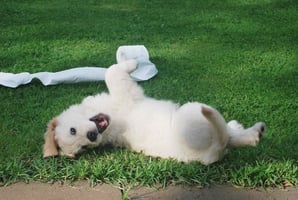Dogs biting their own tail can be a sign of anxiety, boredom, or a medical issue. If your dog is...
Tackling Your Dog's Chewing of the Tip of Its Tail
If your dog is chewing the tip of its tail, it can be a worrying sign. It may indicate that your pup is stressed, anxious, or in pain. Fortunately, there are several steps you can take to help your pup stop this behavior and feel better. In this article, we will discuss the causes of tail-chewing, the best ways to stop it, and how to make sure your pup is comfortable and healthy.
What Causes Tail-Chewing?
Tail-chewing is a common behavior among dogs, and there are several potential causes for it. The most common cause is anxiety. If a pup is feeling anxious or stressed, they may resort to tail-chewing as a way to cope. It can also be a sign of boredom or frustration, especially if they don't have enough mental stimulation or exercise.
In some cases, tail-chewing can be a sign of pain or discomfort. Itchy skin, parasites, or a skin infection can all lead to tail-chewing. It is important to take your pup to the vet to rule out any medical issues.
How to Stop Tail-Chewing
Once you have identified the cause of the tail-chewing, you can start to work on stopping it. Here are some of the best ways to do this:
- Provide mental stimulation: Make sure your pup is getting enough mental stimulation and exercise. Take them for walks, play games with them, and give them toys to keep them occupied. This will help to reduce anxiety and boredom, which can lead to tail-chewing.
- Avoid punishment: Punishing your pup for tail-chewing will only make them more anxious, so avoid this approach. Instead, focus on positive reinforcement and reward them for good behavior.
- Try distraction techniques: If you catch your pup tail-chewing, try to distract them with a toy or a treat. This will help to break the cycle of anxiety and tail-chewing.
- Talk to your vet: If the tail-chewing is due to a medical issue, your vet may be able to provide treatment or medication to help. They may also be able to recommend supplements or dietary changes to help your pup feel better.
It is also important to make sure your pup is comfortable. Make sure their bedding is clean and comfortable, and that they have plenty of toys and chews to keep them occupied. If your pup is anxious, try to create a calm and safe environment for them.
Preventing Tail-Chewing
Once you have stopped your pup's tail-chewing behavior, it is important to take steps to prevent it from happening again. Here are some tips to help you do this:
- Provide plenty of exercise: Make sure your pup is getting enough exercise and mental stimulation every day. Regular walks, play time, and interactive toys can help to keep them active and entertained.
- Keep them occupied: Make sure your pup has plenty of toys and chews to keep them occupied. This will help to reduce boredom and the urge to chew their tail.
- Create a safe environment: If your pup is anxious, try to create a calm and safe environment for them. Make sure their bedding is comfortable, and that they have a quiet place to rest.
- Talk to your vet: If your pup is still exhibiting tail-chewing behavior, talk to your vet. They may be able to recommend supplements or medication to help them feel better.
Tail-chewing can be a sign of anxiety, boredom, or pain in dogs. If your pup is exhibiting this behavior, it is important to identify the cause and take steps to stop it. Providing plenty of exercise and mental stimulation, avoiding punishment, and creating a safe environment can help to reduce anxiety and stop tail-chewing. If the tail-chewing persists, talk to your vet for advice.



